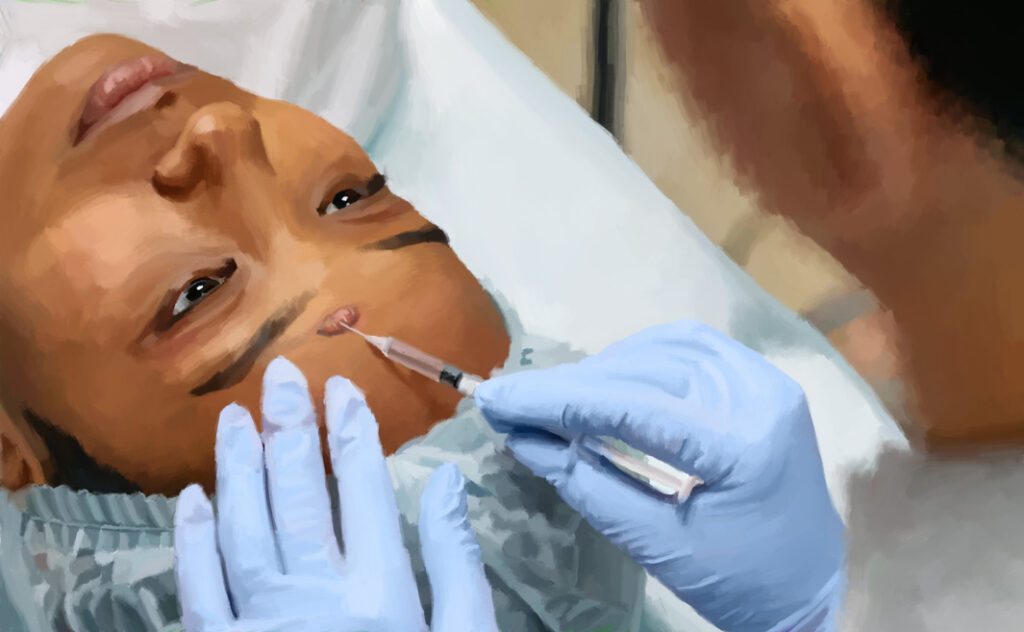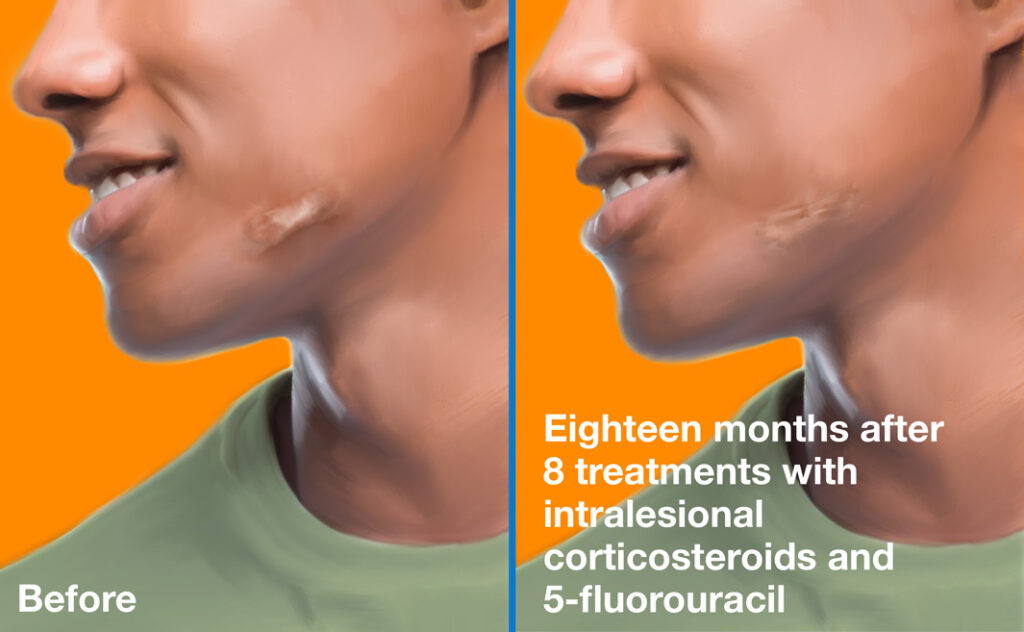Raised and keloid scars are raised scars containing excessive collagen, or in other words, scars that are caused by an overgrowth of collagen.
Intralesional corticosteroid with intralesional 5-Fluorouracil (5-FU) treatment consists of simultaneously injecting the combination of these two drugs directly into the scar (“intralesionally”).1,2
The treatment can be painful and often requires multiple (4-8) sessions.
These drugs carry a lower risk of side effects compared to some other raised scar treatments such as radiotherapy.1-4
Corticosteroids are synthetic (made in a laboratory) drugs that work similarly to natural human hormones. When they are injected into raised scars, they may help reduce scar size by:
- Stimulating collagen breakdown
- Decreasing collagen production
- Decreasing fibroblasts (cells that produce collagen)
- Reducing inflammation (which is what led to scar formation in the first place)5
The addition of 5-FU, which is a type of drug called a cytotoxic drug (“toxic to cells”), contributes further to the reduction of raised and keloid scars. Raised scars are somewhat similar to benign (non-cancerous) tumors. In cancer treatment, cytotoxic drugs are used to kill tumor cells. When it comes to raised scars, the cytotoxic agent 5-FU works by killing or slowing the production of fibroblasts (cells that make collagen) in scarred skin. Fewer fibroblasts should lead to less collagen production and a smaller and flatter scar.6
Because this combination is relatively safe and inexpensive, intralesional corticosteroids with 5-FU is often used for raised and keloid scars.
As with all scar revision treatments, the combination of intralesional corticosteroids with 5-FU is sometimes combined with other scar revision procedures to achieve the desired results.
Before agreeing to undergo intralesional corticosteroids with 5-FU treatment, discuss your options, expected outcomes, and prices with multiple doctors.
Procedure details:
Before administering the corticosteroid with 5-FU, the doctor will clean (disinfect) the scar.
The most commonly used intralesional corticosteroid for raised and keloid scar treatment is triamcinolone. Triamcinolone is combined with 5-FU and injected into the middle of the dermis, the deeper skin layer that is still intact underneath the raised scar.1-4 Injecting the drug into the middle of the dermis also reduces the chances of skin thinning (atrophy), which can be a side effect of intralesional corticosteroids with 5-FU treatment.1-4,8

Depending on the extent of the scarring, the doctor may adjust several factors in intralesional corticosteroid with 5-FU treatment:
- Number of treatment sessions: Larger scars require more sessions than smaller scars. In general, multiple sessions (up to 8) are necessary. If there is no improvement at all after 4 treatment sessions, treatment is normally stopped.
- Time between treatment sessions: This varies from 1 to 6 weeks, but is usually 1 week.
- Dose: Typical doses of corticosteroids are 10-20 mg/ml, but can be as high as 40 mg/ml for very thick scars. The doctor must weigh the efficacy of the treatment, which tends to increase with a higher dose, against the risk of side effects, which also increases with a higher dose. When it comes to 5-FU, most doctors administer 25-150 mg of 5-FU per session, once again depending on the size and thickness of the scar.1-4
Anesthesia:
Before the treatment, the doctor may numb the scar by:
- Mixing the corticosteroid and 5-FU with an anesthetic in the same syringe
- Injecting a local anesthetic prior to the procedure
- Applying a topical numbing cream 30 to 60 minutes prior to the procedure
Before-and-after:

A keloid scar before and 18 months after 8 treatments with intralesional corticosteroids and 5-FU.
References
- Khalid FA, Mehrose MY, Saleem M, Yousaf MA, Mujahid AM, Rehman SU, Ahmad S, Tarar MN. Comparison of efficacy and safety of intralesional triamcinolone and combination of triamcinolone with 5-fluorouracil in the treatment of keloids and hypertrophic scars: Randomised control trial. Burns. 45(1), 69-75 (2019).
- Hietanen KE, Järvinen TA, Huhtala H, Tolonen TT, Kuokkanen HO, Kaartinen IS. Treatment of keloid scars with intralesional triamcinolone and 5-fluorouracil injections – a randomized controlled trial. J Plast Reconstr Aesthet Surg. 72(1), 4-11 (2019).
- Alamdari, H. A., Davarnia, G., Ghadim, H. H., & Sadri, A. Intralesional Cryotherapy Versus Intralesional Corticosteroid and 5-Fluorouracil in the Treatment of Hypertrophic Scars and Keloids: A Clinical Trial. Crescent Journal of Medical & Biological Sciences, 5(3) (2018).
- Srivastava, S., Patil, A. N., Prakash, C., & Kumari, H. Comparison of intralesional triamcinolone acetonide, 5-fluorouracil, and their combination for the treatment of keloids. Advances in Wound Care, 6(11), 393-400 (2017).
- Darzi MA, Chowdri NA, Kaul SK, and Khan M. Evaluation of various methods of treating keloids and hypertrophic scars: a 10-year follow-up study. Br J Plast Surg. 45(5), 374-9 (1992).
- Khan MA, Bashir MM, Khan FA. Intralesional triamcinolone alone and in combination with 5-fluorouracil for the treatment of keloid and hypertrophic scars. J Pak Med Assoc. 64(9), 1003-7 (2014).
- Ledon JA, Savas J, Franca K, Chacon A, and Nouri K. Intralesional treatment for keloids and hypertrophic scars: a review. Dermatol Surg. 39(12), 1745-57 (2013).
- Levy LL, and Zeichner JA. Management of acne scarring, part II. A comparative review of non-laser-based, minimally invasive approaches. Am J Clin Dermatol. 13(5), 331-340 (2012).
- A. Darougheh, A. Asilian, F. Shariati, Intralesional triamcinolone alone or in combination with 5‐fluorouracil for the treatment of keloid and hypertrophic scars, Clinical and Experimental Dermatology, 34 (2), 219–23 (2020).
 Acne.org Products
Acne.org Products